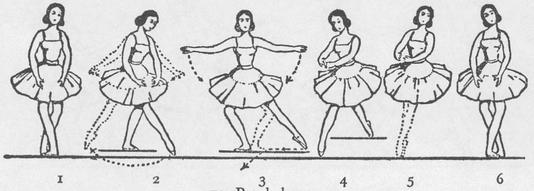Basic Principles of Classical Ballet (17 page)
Read Basic Principles of Classical Ballet Online
Authors: Agrippina Vaganova

SISSONNE FERMÉE (CLOSED)
As an example I shall analyse here one form of sissonne fermée; all others are done the same way, all that changes is the direction.
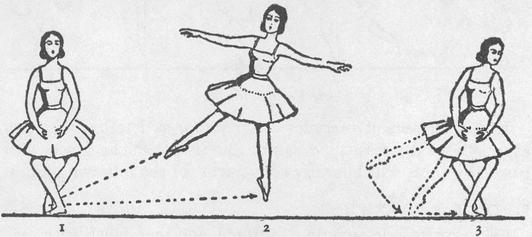
68. Sissonne fermée
Sissonne Fermée, Écarté en Avant. 5th position, right foot front, demi-plié, the jump is not up but to the side; the entire body flies to left; right leg opens into 2nd position, and when the left foot steps on the floor, the right one closes in 5th position together with the left one; the right foot is brought to the left one with the toe gliding on the floor. The jump is not big, and the leg is not raised high.
SISSONNE FONDUE
If we want to do a high jump with the leg raised to 90°, we get not a sissonne fermée, but a sissonne fondue. A high développé will not allow the right leg to finish the jump simultaneously with the left one, and the joining of the legs will assume the character of fondue; the toe should not glide over the floor, but the foot should be softly put on the floor, slightly bending the leg. The arms and head work are in correspondence with the required pose. In this manner sissonne fondue is studied in the advanced classes.
SISSONNE TOMBÉE
5th position, right foot front, demi-plié, jump with both feet in the air. With a passing movement the right foot is placed sur le cou-de-pied or at the knee, depending on whether the step is to be big or small. Fall in plié on left leg, the right leg is immediately taken out in the required direction croisé or effacé, then fall on it in plié as if belatedly.
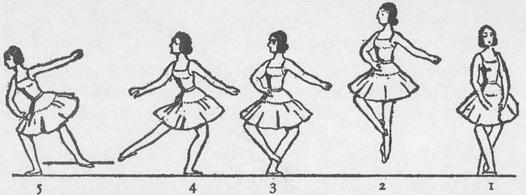
69. Sissonne tombée
If this movement precedes a big jump, as it often happens, especially in the masculine dance, this sissonne may finish with pas de bourrée, which is very convenient for the following jump.
SISSONNE RENVERSÉE
First do sissonne ouverte in attitude, and then finish with renversé. One should not rise on half-toe after the jump in attitude, but the jump should be joined with the next movement, renversé, through pas de bourrée, i..e step on the other foot on half-toe and conclude renversé.
SISSONNE SOUBRESAUT
Sissonne soubresaut is executed as sissonne ouverte, but at the beginning of the jump from the 5th position both heels are held together, as in soubresaut. At the beginning of the jump the body bends forward and during the flight forcefully bends back. The execution must be very precise, the legs, during the flight, should not open and beat each other, so as to avoid getting a form of a cabriole from 5th position. It is effective and convenient to execute this pas several consecutive times, diagonally in attitude effacée, adding, after the fall in plié, in attitude on the right leg, a coupé with the left leg, and assemblé with the right forward, moving in the direction of écarté (point 2).
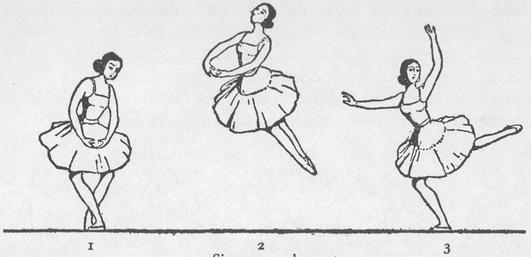
70. Sissonne soubresaut
SOUBRESAUT
Soubresaut is a jump from both feet onto both feet.
Push off the floor, fly forward with extended arches and toes without opening the legs and feet. Before the beginning of the jump the body inclines forward at the beginning and then forcefully bends back, so that the legs remain at the back. Attention should be paid that in joining the legs the calves do not hit each other, otherwise you get a form of cabriole. Many make this mistake.

71. Soubresaut
To get the correct form, the legs should not be joined in their full length; join forcefully the lower parts of the soles.
Lower yourself simultaneously on both feet. The arms in soubresaut are free and depend only on the general design of the dance.
ROND DE JAMBE EN L’AIR SAUTÉ
The study of rond de jambe en l’air sauté begins in the following manner: after doing sissonne ouverte to the side in 2nd position, do rond de jambe en l’air with a simultaneous jump on the supporting foot. Double rond de jambe is done in the same manner. In subsequent studies rond de jambe en l’air is done with a simultaneous jump from demi-plié in 5th position. At the beginning this movement is done with the leg raised to 45°, and later, in the advanced classes, with the leg raised to 90°.
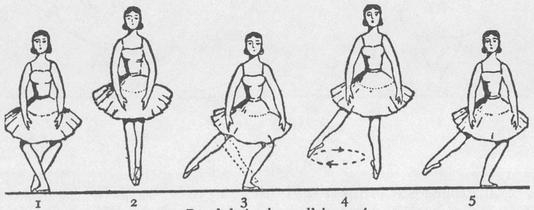
72. Rond de jambe en l’air sauté
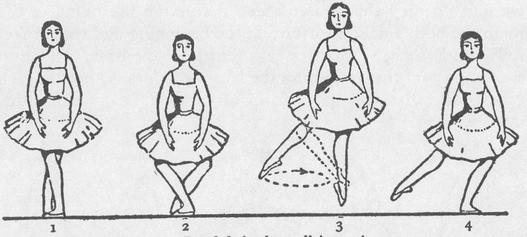
73. Rond de jambe en l’air sauté
PAS DE CHAT
Stand in 5th position, left foot front. Throw the right leg, half-bent, back into 45° croisé, at the same time do demi-plié on the left foot. Push off with the left foot, throwing the left leg, half-bent, back in effacé to meet the right one. There must be a moment when both feet are in the air at the same time, passing each other. Keeping the upper part of the legs turned out, and without opening them too wide, fall first on the right foot, then on the left one. The left foot passes forward into 4th position. One may finish it also in 5th position.
When the body is on the left foot it should have a slight tilt forward, to give it a chance to bend more backward.
At the moment when both feet are in the air, the entire body bends backward, the waist forcefully arched. This pas is embellished by the position of the head. The head may be held in various ways, as long as it correctly follows the movement.

74. Pas de chat
The arms fly up with a soft movement: the right one in 2nd position, the left one forward from the preparatory position into a not-too-high level. The hands are dropped at the beginning, but later are thrown upward. The character of the movement of the arms is analogous to the character of the movement of the legs; the same soft throws which explains the name of the movement—cat-like.
The Italian pas de chat lacks this cat-like character. If the left leg is thrown to the side softly, the right one, which began the movement, is thrown into 2nd position in a dry manner, and the body, usually, does not underline the softness of the entire
pas.
PAS DE BASQUE
This movement is in three counts and is done the following way:
Stand in 5th position, right foot front. On the up-beat (
and
): demi-plié, slightly throwing up the arms towards 2nd position before the beginning of the movement; right foot glides forward, croisé, and describes a half-circle, en dehors (the left foot remains in plié).
On
one
, jump onto the right foot in demi-plié without getting off the floor; (the arms at this moment join in the preparatory position). On
two
—the left foot, opened in 2nd position with toes extended, glides through 1st position into croisé forward. On
three,
the final count, a jump is made which joins both feet in 5th position in demi-plié. This jump is done close to the floor. With a gliding movement both feet move forward with extended toes, without leaving the floor, and end in 5th position. This manner of execution justifies the importance of the movement as a jump par terre. On
two
the arms move through 1st position, and on
three
the hands open slightly. From here the movement continues, the arms moving through 2nd position, etc.
